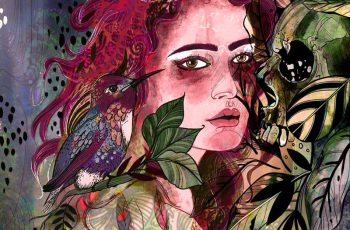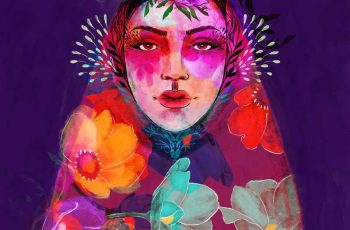The influence of pop culture on art goes far beyond trends or aesthetics, it reflects who we are as a society. Every movie, song, or image we consume leaves traces in our imagination, shaping how artists translate emotion, politics, and identity onto their canvases.
Pop culture shapes not only what we consume but also how we feel, create, and see the world. More than entertainment, it is a mirror of society, a living reflection of our obsessions, desires, and collective discontent. It can be playful, ironic, or deeply political. Every melody, film scene, or brushstroke carries the pulse of its time, the rebellion, hope, and longing that define an era.
From the cinema screen to the rhythm of music and the colours of contemporary painting, art and pop culture live in constant dialogue — a creative exchange that transforms them both.
The Influence of Pop Culture on Art and Cinema: The Art That Moves and Moves Us
Cinema has always been more than storytelling. It translates collective feelings and universal archetypes, becoming both reflection and prophecy.
It reveals what societies once were, what they dream to become, and what they fear to face.
From Andy Warhol to David Lynch, cinema inspired painters and visual artists to reinterpret reality through light, colour, and symbolism to communicate, subtly or boldly, with a world hungry for meaning.
Cinematography reshaped the way we compose images: framing, atmosphere, and the language of light began to influence painting, photography, and installation art. Today, many works resemble frozen film frames, silent stories that invite viewers to imagine what happened before and after that moment… or whether it ever happened at all. Perhaps it was merely a dream, a reflection of a society longing for more, revealing its desires through the screen.
The Influence of Pop Culture on Art and Music: The Rhythm That Paints Emotion
Music has always been a creative engine for visual artists. Every note, beat, or pause can be translated into colour, texture, or movement. Sound waves themselves draw invisible shapes in the air simply by existing.
Kandinsky believed that sound and colour shared the same spiritual frequency, one could feel what the other expressed. In contemporary art, pop music has become both muse and manifesto: the rebellion of rock, the melancholy of indie, the elegance of jazz, the social fire of rap. By merely changing the radio station, we leap between emotional universes — rage, love, sorrow, joy — and art absorbs them all.
In the digital era, music defines visual language. Album covers, music videos, and even playlists have become complete artistic experiences, immersive narratives that merge sound, image, and identity into one cohesive aesthetic.
Painting and Pop Aesthetics: Everyday Life as Manifesto
When Andy Warhol painted soup cans and celebrity portraits, he turned the banal into art and art into a mirror of society. Was it irony? Admiration? A provocation? No one truly knows. But that’s the beauty of it, art lives in interpretation. What does it awaken in you? What emotion does it leave behind?
From that moment on, the concept of “high art” began to dissolve. Today, pop is not just a style, it’s a language: accessible, democratic, and dangerously close to becoming banal. A selfie, a post, a meme, a song — all can be art.
Yet the very freedom that made art democratic also demands responsibility; without awareness, the line between creation and noise becomes thin.
Some contemporary artists embrace the fusion between the sacred and the commercial, while others reject it, believing that what sells cannot also be profound.
But this view limits art itself. To dismiss the commercial is to deny that art can exist in every world, the intimate, the public, the sacred, the market.
Art is not defined by where it lives, but by what it provokes.
Painting, once introspective, now speaks directly to the collective, triggering an immediate, sensory response.And in the age of global sharing, a single post can reach the world in seconds. Once it’s out there, there is no going back, even if deleted, it lingers in memory.
The Fusion of the Sacred and the Popular
Beneath the vibrant surface of pop aesthetics lies something deeper: the search for meaning amid excess. Can we compare graffiti to urban art? Perhaps, both are forms of human voice reclaiming public space. We live surrounded by noise, images, and constant distraction. Art becomes the sacred pause, the act of transforming chaos into coherence.
Each piece inspired by pop culture is, at its core, an attempt to find beauty in the noise. And finding beauty in the noise is no small feat; those who do deserve applause. Pop culture influences art, but art also reshapes pop culture, an infinite cycle of mirror and muse.
It is the portrait of humanity trying to understand itself: a frame of emotion where colour and sound reveal not only who we are but who we wish to be. And we must not forget all of this is also about desire, one of the most human forces of all.
More soul, more stories, right this way:
- What Is Creativity and How to Be Creative: Science and Tips
- Concrete Art: A Complete Guide to the Movement
- Bohemian Rhapsody and Crime and Punishment: Two Souls, One Cry
Conclusion
Pop culture is the stage of modernity, where art and everyday life intertwine, dissolving borders and hierarchies. Cinema, music, painting, all feed from and feed into each other. The artist observes the world, the world absorbs the artist, and creation continues its eternal dance. It is in this exchange that timeless works are born, the ones that make time stop for a second and remind us that living, too, is an art form.
FAQ – Influence of Pop Culture on Art
1) How does pop culture influence art?
Through cinema, music, and media imagery — pop culture shapes themes, aesthetics, and the emotional language of modern art.
2) Can art also influence pop culture?
Absolutely. Many visual trends and fashion movements originate in fine art before being absorbed by mainstream culture.
3) Why do artists use pop symbols?
Because they carry shared meaning — instantly recognisable images that allow art to question consumerism and identity.
4) Is commercial art still “true art”?
Yes. Art’s value lies in its ability to provoke emotion and thought, not in its market label.
5) How are music and painting connected?
Both evoke rhythm, movement, and feeling — translating emotion through different senses: one through sound, the other through colour.


